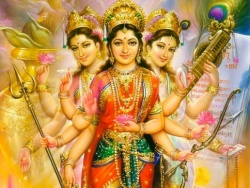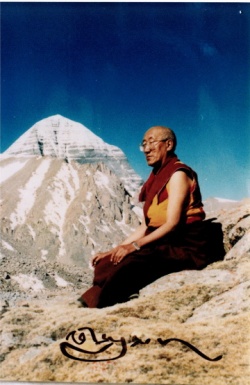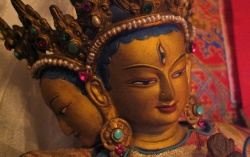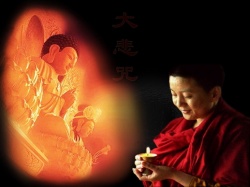On Offering Prayers to the Mandala of the Mystic Law
HAVE offered prayers to the Gohonzon of Myoho-renge-kyo. Though this mandala has but five or seven characters, it is the teacher of all Buddhas throughout the three existences and the seal that guarantees the enlightenment of all women. It will be a lamp in the darkness of the road to the next world and a fine horse to carry you over the mountains of death. It is like the sun and moon in the heavens or Mount Sumeru on earth. It is a ship to ferry people over the sea of the sufferings of birth and death. It is the teacher who leads all people to Buddhahood and enlightenment. This great mandala has never yet been propagated anywhere in Jambudvīpa in the more than 2,220 years since the Buddha’s passing.
[The prescription of] medicine differs according to the illness. A slight ailment can be treated with ordinary medicine, but for grave illnesses, an elixir should be used. During the more than 2,220 years since the Buddha’s passing, the people’s illnesses of earthly desires and negative karma were not serious, and a succession of wise men appeared in order to act as physicians and dispense medicine appropriately as these illnesses required. These men came from the Dharma Analysis Treasury school, the Establishment of Truth school, the Precepts, Dharma Characteristics, and Three Treatises schools, as well as the True Word, Flower Garland, Tendai, Pure Land, and Zen schools. Each of these schools prescribed its own medicine. For example, the Flower Garland school set forth the principle of the six forms and the ten mysteries, the Three Treatises school advocated the middle path of the eight negations,1 the Dharma Characteristics school stressed the perception that all phenomena derive from consciousness only,2 the Precepts school upheld the two hundred and fifty precepts, the Pure Land school invoked the name of Amida Buddha, the Zen school expounded the “perceiving one’s true nature and attaining Buddhahood,” the True Word school propounded the meditation on the five elements,3 and the Tendai school taught the doctrine of three thousand realms in a single moment of life.
Now, however, we have entered the Latter Day of the Law, and the medicines of these various schools no longer cure the people’s illnesses. Moreover, all the Japanese have become icchantikas and people of grave slander. Their offense is even worse than that of killing one’s father or mother, fomenting a rebellion, or causing a Buddha to bleed. Japan is filled with individuals whose respective offenses exceed even those of one who were to gouge out the eyes p.415of all the human beings of a major world system, or raze all temples and pagodas in the worlds of the ten directions. Consequently, the heavenly deities glare down furiously upon our nation day after day while the earthly deities tremble in continual rage. Nevertheless, all the people of our day believe themselves to be without fault, and none doubt that they will be reborn in the pure land or attain Buddhahood.
The blind cannot see or know the shining sun, and someone who is sound asleep will not feel even an earthquake that is reverberating like a great drum. So too it is with all the people of Japan [who do not realize their own offenses]. The offenses committed by the men are heavier than those committed by the women. In like manner, the nuns’ offenses are heavier than the laymen’s and the priests’ more serious than the nuns’. Among the priests, the offenses of those who observe the precepts are worse than those of priests who violate them, and those of learned priests are graver still.4 Such priests are like those with white leprosy among lepers and, among those with white leprosy, the most malignant.
Then, what great physician or what efficacious medicine can cure the illnesses of all people in the Latter Day of the Law? They cannot be cured by the mudras and mantras of the Thus Come One Mahāvairochana, the forty-eight vows of the Thus Come One Amida, or the twelve great vows of the Thus Come One Medicine Master, not even his pledge to “heal all ills.” Not only do such medicines fail to cure these illnesses; they aggravate them all the more.
Shakyamuni Buddha, the lord of teachings, brought together the Thus Come One Many Treasures and all the emanation Buddhas of the ten directions, and left one elixir—the five characters of Myoho-renge-kyo—for the people of the Latter Day of the Law. He refused to entrust it to any of the bodhisattvas such as Dharma Wisdom, Forest of Merits, Vajrasattva, Universal Worthy, Manjushrī, Medicine King, and Perceiver of the World’s Sounds, let alone to Mahākāshyapa, Shāriputra, [or any other person of the two vehicles). Rather, there were four great bodhisattvas, including Superior Practices, who had been disciples of the Thus Come One Shakyamuni since [he first attained Buddhahood) numberless major world system dust particle kalpas ago. Not even for a moment had they ever forgotten the Buddha. Shakyamuni summoned these great bodhisattvas and transferred Myoho-renge-kyo to them.
A woman who takes this efficacious medicine will be surrounded and protected by these four great bodhisattvas at all times. When she rises to her feet, so too will the bodhisattvas, and when she walks along the road, they will also do the same. She and they will be as inseparable as a body and its shadow, as fish and water, as a voice and its echo, or as the moon and its light. Should these four great bodhisattvas desert the woman who chants Nam-myoho-renge-kyo, they would incur the wrath of Shakyamuni, Many Treasures, and the emanation Buddhas of the ten directions. You may be certain that their offense would be greater than even that of Devadatta, their falsehood more terrible than Kokālika’s. How reassuring, how encouraging! Nam-myoho-renge-kyo, Nam-myoho-renge-kyo.
Nichiren
Neither the date nor the recipient of this letter is known. But it is generally supposed that the letter was given to the lay nun Sennichi, the wife of Abutsu-bō, in the tenth year of Bun’ei (1273). The “Mystic Law” in the title indicates both the five characters of Myoho-renge-kyo and the seven characters of Nam-myoho-renge-kyo. The mandala of the Mystic Law refers to the Gohonzon—the object of devotion inscribed by Nichiren Daishonin with Nam-myoho-renge-kyo down its center. The Daishonin also mentions elsewhere that the daimoku of the Lotus Sutra should be made into an object of devotion.
In terms of the principle of three thousand realms in a single moment of life, the daimoku down the center of the Gohonzon represents the enlightened “single moment of life” of Nichiren Daishonin, and the characters on both sides of it, “the three thousand realms.” Because the former includes the latter, the Daishonin says that “this mandala has but five or seven characters.”
The Daishonin emphasizes that Nam-myoho-renge-kyo is the medicine that will cure the illnesses (that is, sufferings) of all people in the Latter Day of the Law, and that the lay nun Sennichi, a woman who chants Nam-myoho-renge-kyo, will be protected by the four bodhisattvas at all times.
Back to Top
Notes
1. “The eight negations” refers to the eight expressions of negation in Nāgārjuna’s Treatise on the Middle Way: “Neither birth nor extinction, neither cessation nor permanence, neither uniformity nor diversity, neither coming nor going.” The doctrine of the eight negations indicates that the Middle Way, or true nature of all phenomena, cannot be defined as either existence or nonexistence; it is non-substantial and transcends all duality.
2. The perception that all phenomena arise from the ālaya-consciousness.
3. The meditation on the five elements is an esoteric form of meditation intended to let one realize that self and environment are composed of the five elements of earth, water, fire, wind, and space; that the five parts of the body, namely, crown, face, chest, abdomen, and knees, are governed by the five syllables of the esoteric mantra avarahakha; and that one’s own life is ultimately one with the five Buddhas who are embodiments of the five aspects of Mahāvairochana Buddha’s wisdom.
4. In this passage the Daishonin states that the more highly respected the perpetrator, the heavier in effect the offense will be. Men had the greater influence in Japanese society, so their errors with respect to Buddhism made a heavier impact than the same errors committed by women. Similarly, the clergy carried more influence than the laity, and, among the clergy, those priests who observed the precepts and were well learned commanded the highest respect; thus their errors had a graver influence on society than anyone else’s.



